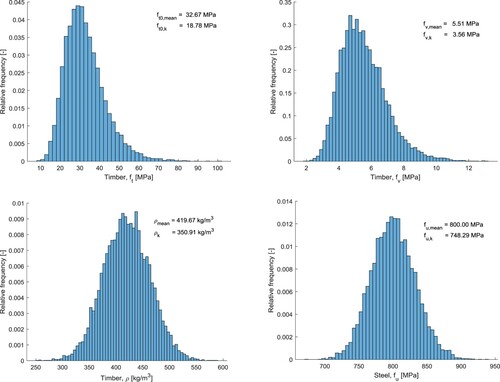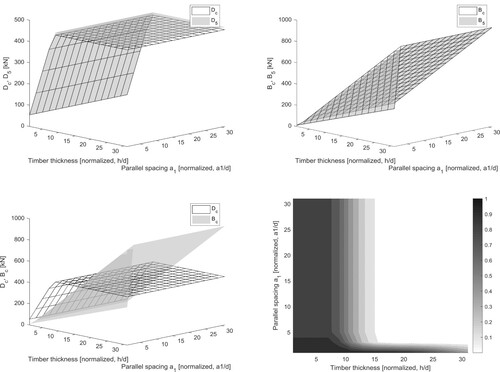 ?Mathematical formulae have been encoded as MathML and are displayed in this HTML version using MathJax in order to improve their display. Uncheck the box to turn MathJax off. This feature requires Javascript. Click on a formula to zoom.
?Mathematical formulae have been encoded as MathML and are displayed in this HTML version using MathJax in order to improve their display. Uncheck the box to turn MathJax off. This feature requires Javascript. Click on a formula to zoom.ABSTRACT
Dowel-type connections in timber structures should be typically designed in a way that, if the load bearing capacity is exceeded, desirable ductile failure should likely occur, i.e. yielding of the metal dowel or embedment of the timber. However, the probability of brittle failures cannot be completely avoided in many cases. If the connection is loaded parallel to the grain direction, splitting, row-shear, plug/block shear and tensile failure are examples of such brittle failure modes. To ensure a beneficial structural performance locally and sufficient structural robustness globally, the probability of such brittle failures should be kept at a sufficiently low level. However, in the current version of EN1995, the probability of such failure is not considered explicitly. The final aim of the presented research study is to develop a rational approach for the consideration of brittle failure in timber connections with dowel-type fasteners and steel plates loaded parallel to the grain, consistently with the partial factor method. As a first step, a probabilistic model has been used to study the susceptibility to brittle failure and provide a rational basis for the calibration of a “brittle overstrength factor”. The results of this study are reported in the current contribution.
Introduction
From an overall safety perspective, it is typically beneficial if connections in timber structures are designed in a way that, in case of failure, desirable ductile behaviour is observed, i.e. yielding of the metal dowel or embedment of the wood. Therefore, the overall trend is to develop such connections that enhance ductility and redundancy, see e.g. (Rossi et al. Citation2016). However, there is always a risk of brittle failure: splitting, row-shear, plug/block shear and tensile failure are potential brittle failure modes for connections loaded in the parallel to the grain direction. Connections have been reported as a key factor involved in almost one quarter of recent collapses of timber structures, where more than half of the involved connections were dowel-type (Frühwald et al. Citation2007, Frühwald Citation2011). It should be mentioned, however, that according to these studies almost all failures occur due to gross human errors. Nevertheless, there is a need to raise the awareness of the brittle failure of connections on one hand, and the need for simple design models in standards.
It is important to understand that probabilistic considerations are needed to provide a rational foundation to successfully eliminate the risks due to brittle failure. A chief goal of this paper is to demonstrate the usefulness and relative simplicity of probabilistic methods and thus promote the application of such methods and the appreciation of uncertainties and risks in timber engineering.
The challenge is to keep the probability of these failure modes at a sufficiently low level in a controlled and informed way, i.e. the probability of occurrence and the consequences should be in balance with the measures of increasing safety and risk to human injuries. Since a detailed probabilistic risk assessment in the design of single connections would be unreasonable the balance should be ensured by structural standards using simplified means of verification, expected to provide relatively consistent results for larger population of connections, thereby leading to a sound scientific basis for the design of timber structures (Fink et al. Citation2018).
In the current version of Eurocode 5 (EC 5, EN1995-1-1 Citation2004), a brittle failure of connections loaded parallel to the grain is not considered appropriately. Although the informative Annex A provides methods for the determination of the block and plug-shear failures; splitting and row-shear failure is not explicitly considered in the code and the risk of brittle failure is minimized by constructive rules rather than calculations. This method can hardly be considered rational, since the actual risk of brittle failure is not quantified and thus cannot be claimed acceptable or tolerable.
In the literature various models exist (Cabrero and Yurrita Citation2018a), which could be implemented in EN1995 to calculate the strength against various brittle failure modes. However, it is important that the characteristic load-carrying capacity associated with the brittle modes should be significantly higher than those of the ductile failure modes. This, i.e. that the probability of brittle failure is as low as intended, could be ensured e.g. by a “brittle overstrength factor”. The value of this factor needs to be determined using a calibration procedure based on probabilistic methods; whereas, the criterion for the determination of the factor should ideally take into account the differences in the consequences between ductile and brittle failure. Another approach could be to account explicitly for various brittle failure modes with the governing equations refined through a code calibration process to ensure that the reliability associated to each failure mode is as low as intended.
In the current study, a preliminary work of a rational approach for the consideration of brittle failure in dowel-type steel-to-timber connections is presented, consistently with the partial factor method used in the Eurocodes. The study describes the stochastic model of the basic variables for some selected connection configurations to investigate the effect of various parameters and to illustrate how the susceptibility to brittle failure could be better understood. With the use of simple Monte Carlo simulations, the probability distribution functions of the ductile and brittle failure modes are obtained. These are compared with the deterministic design equations and the susceptibility to brittle failure are evaluated. It should be noted that in an assessment of the structural system, it is important that the structural model should appropriately describe the structural behaviour both at global and local level to form the basis of a probabilistic assessment.
Brittle failure in timber connections with dowel-type fasteners
Failure modes
A connection may fail under two major types of failure, namely ductile or brittle. The ductile failure relies on the yielding of the fastener and the plastic deformation of the timber under embedment stresses. It is the desired failure, since the connection is able to maintain the failure load while developing noticeable deformations, i.e. the loss of structural integrity does not happen suddenly. The load-carrying capacity in the ductile failure modes can be estimated by the equations of the so-called European Yield Model given in Eurocode 5 (EC5, EN 1995-1-1 Citation2004).
In many cases the final failure of the connection will be a brittle mechanism. If such failure occurs after sufficient plastic deformation (and, therefore, sufficient ductility) it is often not a major issue, as the governing failure was ductile. However, it could be a problem if such brittle failure happens before the evolution of the ductile failure mode, or before reaching sufficient deformation in the connection e.g. through yielding of the fastener. Such early brittle failure mechanisms should be avoided, and the designer should be provided with guidance in the form of e.g. a set of equations which allows for the determination of the onset of brittle failure.
However, despite their crucial importance, such brittle failure mechanisms have been usually omitted in the design standards, as it is the case in the current Eurocode 5. They were included as the informative Annex A, only after some problems, such as the issues at the Utopia Pavilion (Biger et al. Citation2000), or partial collapses, e.g. Jyväskylä Fair and Ballerup Arena (Hansson and Larsen Citation2005), which happened in buildings were the pre-normative version of the Eurocode 5 had been used. The Canadian standard CSA-O86, or the future version of the New Zealand standard already have them explicitly included. In both cases, the proposed design models are based on the works by Quenneville e.g. (Quenneville Citation1998, Quenneville and Mohammad Citation2000, Zarnani and Quenneville Citation2014a, Citation2014b).
The present study deals with the brittle failure mechanisms of connections with “large” diameter fasteners which protrude the whole timber thickness (i.e. bolts, dowels). As shown in , the possible brittle failure mechanisms are splitting (the opening of a longitudinal crack along the row of fasteners), row shear (the slippage of two lateral longitudinal planes in each row of fasteners) and block shear (produced by the failure of the timber of the connection area, defined by two lateral longitudinal planes and a head plane).
Figure 1. The different types of brittle failure for connections with large diameter fasteners and the definition of the lateral L and the head H failure planes for the row and block shear failure modes.
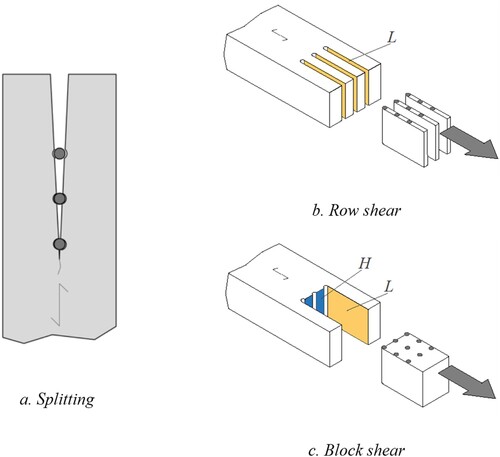
Brittle failure relates with the presence of sufficient timber volume which is able distribute the load introduced by the fasteners. These failures have usually been prevented in the standards by ensuring sufficient spacing between the fasteners, and by later applying a reduction factor (effective number of fasteners) to the ductile capacity. Such simple rules might not be always safe and satisfactory, as it will be shown in this paper. Besides, these approaches conceal brittle failure, leading to the unawareness of the designer. As shown in a recent survey conducted in the COST Action FP1402 (Stepinac et al. Citation2018) to more than 400 practitioners, over 70% of them were not aware of the possibility of brittle failure. Several design models for the capacity of the different brittle failure modes of connections have been proposed in the literature. For a complete description, the reader is referred to Cabrero and Yurrita (Citation2018a, Citation2018b).
Ductile model
The primary calculation model to estimate the load-carrying capacity of a connection relies on the assumption of ductile failure of the fastener and the surrounding wood. It is the European Yield Model (EYM), which is based on the early development by Johansen (Citation1949). It gives the load-carrying capacity of the individual fastener in a connection in dependency of the different possible yielding modes of the fastener.
Eurocode Citation5 (Citation2004) includes brittle failure in two different ways: In its normative part, brittle failure is considered by means of a reduction of the ductile capacity according to EYM by considering an effective number of fasteners nef, which is smaller or equal the actual number of fasteners n. The model behind this parameter was developed by Jorissen (Citation1998) and considers namely the tension perpendicular to the grain and the corresponding shear produced in the timber member by the loaded fastener. Hence, it might be assumed as an implicit way to consider spitting and row shear failures. As a consequence, brittle failures are not implicitly mentioned in the current European standard, and they are disguised under the nef parameter.
Additionally, the Eurocode includes in an informative Annex an additional model to obtain the capacity of a connection with steel plates under plug and block shear failure. As mentioned before, a survey within the COST Action FP1402 (Stepinac et al. Citation2018), showed that the problem of brittle failure is mostly unknown for the European practitioners. As proved by the survey, due to their crucial importance in terms of safety, brittle failure modes should be included within the normative part of the Eurocode.
Brittle failure model
Most of the existing models to obtain the brittle capacity of timber connections have been reviewed, benchmarked and compared in Cabrero and Yurrita (Citation2018a, Citation2018b). In the present study, the brittle model which has been proposed for the future New Zealand draft (Quenneville and Zarnani Citation2017) has been used. As explained in Cabrero and Yurrita (Citation2018b), it is a simple to understand and practical model. It has been extensively used for the design of timber structures, since it is included in a similar form in the Canadian Standard since 2000. As shown in the study performed by Cabrero and Yurrita (Citation2018b), where most of the existing design proposals for brittle failure modes where analysed, compared and benchmarked against an extensive database of experimental tests, it is a reliable model, and it constitutes a complete system, in which a calibration between the ductile (EYM) and brittle failure modes has already been done. Due to this fact, it is the model used in this work. Alternative models (such as Hanhijarvi and Kevarinmaki Citation2007 are not explained in this work). The reader is referred to Cabrero and Yurrita (Citation2018a, Citation2018b) for the explanation and benchmarking of other proposals (such as the current Eurocode 5, or Hanhijärvi and Kevarinmäki Citation2008).
The model by Quenneville describes the different brittle failure modes as the different failure planes involved in the resulting failure mechanism, as shown in . Due to its practical orientation, some critical aspects (load distribution among fasteners, influence of loaded area …) are simplified and included into different assumptions and parameters in order to provide a simple-to-use model. The lateral L and head H planes are assumed to fail under shear and tensile stress, respectively. The capacities of the lateral L and the head H planes are given by (see ),(1)
(1)
(2)
(2)
The different geometrical parameters are given in , being nc the number of columns in a fastener group, hw the thickness of the timber member and bnet the net width of the connection. The distance aL,min is the minimum between the parallel spacing between the fasteners a1 and the end spacing a3 (conservative approach verified by the fracture based model developed by Jensen and Quenneville Citation2011). It is considered that the minimum of these distances trigger failure. As a consequence, the length of the lateral plane L is reduced in this model. The parameter KLS (which takes into account the uneven load distribution along the fastener) is either 0.65 for side, or 1.00 for middle timber members. The factors 0.75 in the case of the lateral plane L and 1.25 for the head plane H simplify the uneven distribution of stresses in the timber member (with similar values as those proposed in the Annex A of Eurocode 5). The strengths fv and ft,0 are, respectively, the timber shear and the parallel tension strength. These plane capacities are simply added to obtain either row shear or block shear capacity, being the brittle capacity of a single timber member for such modes:(3)
(3)
(4)
(4)
Figure 2. Analysed connections types, with the definition of the different geometrical parameters. From left to right: front view of the connections; lateral view of the two analysed types WSW and SWS.
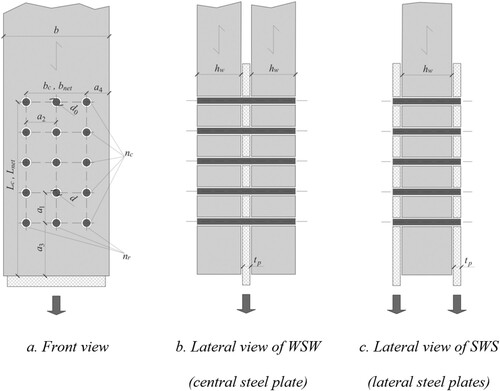
The brittle capacity of the member is the minimum between these latter capacities, Fr-s and Fb-s. As the brittle failure is explicitly included as a model, the New Zealand draft no longer reduces the number of fasteners for the ductile mode, as currently proposed in the Eurocode 5.
Studied connections
Two typical timber connections with steel plates and dowel-type fasteners have been analysed in the present study (): a wood-steel-wood (WSW) (with internal steel plate) and a steel-wood-steel (SWS) (with internal wood member). In both cases, thick steel plates have been assumed. Three rows and five columns of fasteners with a diameter of 12 mm have been chosen. The load application is in the rows’ direction (i.e. vertical in ).
To study the effect of changing of typical design parameters, the thickness of the timber member and the parallel spacing between the fasteners have been chosen. Both parameters play a major role on both types of failure, ductile and brittle. The thickness of the timber relative to the fastener diameter modifies the ductile failure mode, from pure embedment (no plastic hinges, very thin timber member) to the development of one and two plastic hinges mechanisms in the timber member as the thickness increases. At the same time, a thicker timber member features a bigger resisting area on the lateral and head planes which fail under brittle, and thus a bigger brittle capacity is obtained. The parallel spacing between fasteners is not considered for the ductile failure (once the implicit brittle model of the effective number is dismissed), but it has a direct relation to the brittle capacity. As a consequence, the Eurocode dictates a minimum spacing to obtain a ductile failure.
Probabilistic assessment
Calculation steps
In the present study, the load-carrying capacity of a connection is calculated as the minimum of the ductile mode load-carrying capacity according to the EYM and the brittle modes load-carrying capacity according to Equations (3) and (4). The estimation of the load-carrying capacity is based on the actual capacity using sample representations of material properties. An example of the model and the applied procedure can be found in (Jockwer et al. Citation2018). The samples of material properties used for the estimation of load-carrying capacity are generated by Monte Carlo simulations and consider the variability of properties of the timber and their correlation as described in JCSS (Citation2006). The Monte Carlo method is a sampling technique to generate random numbers from probability distributions. Through the sampling, realizations of stochastic variables can be obtained, virtual observations and experiments can be carried out, and the results can be statistically analysed, for more details about the method the reader is referred to e.g. Hammersley and Handscomb (Citation1975).
Stochastic modelling of input data
Timber, as a natural material, exhibits considerable variations in its material properties. In the product standards for glued laminated (EN 14080, Citation2013) and structural (solid) timber (EN 338, Citation2016) characteristic values for the respective strength and stiffness values are given, which can be applied in design according to Eurocode 5 (EN 1995, Citation2004). The characteristic values according to EN Citation384 (Citation2016) are partly related to the results of tests according to EN Citation408 (Citation2012), such as bending strength or bending modulus of elasticity (MOE), and partly prescribed in order to account for certain considerations regarding safety and structural performance, such as tension or compression perpendicular to the grain strength. The characteristic values are commonly 5th-percentlie values (for strength) or mean values (for stiffness) according to EN 14358 (Citation2016). These values are meant to be used in design equations in structural codes to maintain sufficiently conservative values for design resistances and ensure that the probability that they are exceeded is correspond to the level required by the safety margin defined in the standard.
In order to estimate the expected load-carrying capacity of a specimen in an individual test, mean values instead of characteristic values have to be used. On the other hand, to calculate the probability of failure under a given load and to determine the likelihood of relevant failure modes statistical description of the uncertain variables is required.
The natural variability of the timber together with the inhomogeneous and fibrous material structure makes the strength and stiffness values somewhat difficult to predict due to differences in the distribution characteristics. These characteristics, i.e. the distribution type and the statistical moments can be calculated from tests in case the sample size is sufficiently large, i.e. a sufficiently large number of individual tests have been carried out. In other cases, it can be referred to the distribution types recommended e.g. in the probabilistic model code of the Joint Committee on Structural Safety (JCSS Citation2006).
The distribution characteristics and parameters, distribution type and coefficient of variation (CV) as proposed in the Probabilistic model code for structural (solid) timber are given in . Additional material properties and parameters not covered by JCSS are marked with an asterisk. The distribution types suggested in JCSS are based on intense discussions in the research community such as during the meetings of COST E24 or CIB-W18. For the majority of the material property values lognormal distributions were suggested. Compression perpendicular to the grain strength and density with a rather small variability are represented by a normal distribution. For the tensile strength perpendicular to the grain a 2-parameter Weibull distribution is suggested. This distribution type exhibits a higher portion of values in the lower tail compared to e.g. the lognormal distribution. This allows for a more conservative representation of very low strength values. If conservativeness is not desired and more realistic values in the lower tail region are needed, it is possible to estimate the parameters of the Weibull distribution by explicit consideration of those values, see Köhler (Citation2007).
Table I. Distribution characteristics according to JCSS (Citation2006) and property values used in the present study.
In general, it could be argued that conservative material parameters will lead to a bias in the probabilistic analysis. To compensate for this, e.g. in reliability assessments, model uncertainties are introduced to cover deviations and simplifications related to the probabilistic modelling and the limit state equations. Since reference properties are determined through standardized testing procedures, model uncertainties related to the estimation of other material parameters (e.g. compression perpendicular to the grain strength) need to be considered.
Furthermore, the simplified limit state equations, such as those used in design codes and adopted in this paper, introduce model uncertainties, as they might be conservative as well. These model uncertainties will depend on the limit state and how much the actual condition differs from the idealized assumptions. These uncertainties can be determined using statistical analysis of test data when compared to the calculation models in the limit state equations. More discussion on this topic can be found in (Köhler Citation2007). The aim of this study was not the estimation of failure probabilities, but rather looking at trends in susceptibility to brittle failure, and model uncertainties has not been considered.
The mean values for stiffness and 5th-percentile values for the strength of the material properties in are based on the values for GL24 h in EN 14080. The respective 5th-percentile values for stiffness and mean values for strength are calculated applying the corresponding distribution type and CV.
Tensile strength perpendicular to the grain and shear strength show considerable dependency on the size and volume of the loaded specimen. The tests for tensile strength perpendicular to the grain according to EN 408 are based on a volume of V = 0.01 m3. The impact of different volumes on the strength is discussed in Aicher et al. (Citation2002) or Mistler (Citation2016). For smaller volume of V < 0.1 dm3, which can be representative for connections, considerable higher mean values of ft,mean > 2 N/mm2 compared to the value in are given by Aicher et al. (Citation2002).
The equation for embedment strength given in EC5 for softwood loaded parallel to the grain is based on studies by Whale and Smith (Citation1986):(5)
(5)
Applying the density values with the distribution characteristics according to in Equation (5) for the generation of embedment strength values will lead to an underestimation of its variability due to the low CV of the density. Leijten et al. (Citation2004) performed a re-evaluation of the test data of Whale and Smith (Citation1986) and additional data and fitted an exponential equation to the data which can be used for the probabilistic representation of the embedment strength:(6)
(6) The distribution characteristics of the parameters A, B, C and D for European softwood are given in .
Especially with regard to e.g. bending stiffness it has to be distinguished between the material properties of the individual lamellas and the behaviour of the entire Glulam-beam. JCSS proposes a CV = 25% for the bending strength of solid timber (the individual lamella of an entire glulam beam) and CV = 13% for the strength of a glulam beam. The evaluation of FE models of glulam beams with Monte Carlo generated material properties supports this relation between the CV of solid timber (lamellas) and glulam (Jockwer Citation2014).
In the present study with the scope on dowel connections the stressed volume of the timber is rather small compared to e.g. beams in bending. Test reported in the literature (e.g. Rammer and Soltis (Citation1994), Aicher et al (Citation2002)) show that in this small volume the mean value of strength is higher compared to the respective standardized values. The stressed volume in tension perpendicular to grain according to EN 408 for glulam is V = 0.01 m3.
In tests for the determination of material properties a certain correlation between the properties given in can be found. However, the exact determination of this correlation is challenging. In most studies the correlation between properties are determined, that can be measured by non-destructive and destructive methods such as density ρ, tensile MOE Et,0 and ft,0 (e.g. Fink Citation2014). The basis for the estimation of the correlation between different strength parameter, which require destructive testing, is much vaguer. The coefficients of correlation given in JCSS are proposed based on discussions in COST E24 and are representation of the qualitative judgement with distinction between high (0.8), medium (0.6), low (0.4), and very low (0.2) correlation.
The correlations for the additional material property values rolling shear strength and rolling shear modulus in were expanded with a lower correlation compared to shear strength and shear modulus.
The correlations of the parameters A, B, C and D for the generation of embedment strength are given in . These parameters are not correlated to the other material properties in and .
Table II. Correlations of parameters A, B, C and D for the generation of embedment strength.
Table III. Correlation of parameters for strength and stiffness values given .
In the equations of the European Yield model in EC5, the relevant material properties are the embedment strength of the timber and the yield moment if the fastener. According to the yield theory the yield moment corresponds to the full plastic bending of the fastener. However, the maximum moment may be reached already at a lower level. Jorissen and Leijten (Citation2005) discuss differences of the elastic and full plastic bending of the fastener. In EC5 the yield moment is related to the ultimate tensile strength of the fastener according to Equation (7):(7)
(7)
The background of this equation is discussed e.g in Jorissen and Blaß (Citation1998). The experimental determination of the yield moment of the fastener My is specified in EN 409. The diameter of the fastener not only has an effect on the moment of inertia of the cross-section but also on the bending angle at which the maximum bending moment is reached: the angle decreases with increasing diameter. In addition, the diameter of the fasteners has an influence on the (intended or unintended) hardening process during the production of the fasteners. Small diameter fasteners often exhibit very high yield strength which is cause by the forging process during production. Sandhaas and Görlacher (Citation2018) evaluated a large set of data from tests on nails and proposed the following equation of yield moment:(8)
(8)
Sandhaas and Görlacher (Citation2018) and Blaß and Colling (Citation2015) found small variabilities within batches of fasteners but rather high differences of strength in-between batches.
Within this paper, the yield moment related to the ultimate tensile strength and diameter of the fastener according to Equation (7) and given in EC5. The material properties of the steel are generated as lognormal distributed parameters with a CV of 4% and a mean value of fu = 800 N/mm2. The MOE of the steel is constant at E = 210’000 N/mm2.
Examples of the distribution of the Monte Carlo generated material properties can be found in . The different shapes of the distributions are clearly visible, e.g. tensile strength parallel to grain ft,0 (lognormal) and density ρ (normal). The different distribution types suggested in JCSS (Citation2006) for these properties are the result of discussions in COST Action E24 (Citation2005) accounting for the desire for accuracy and the ease of application/simplicity.
Results
In this section, the results of the Monte Carlo simulations are presented. It should be noted that the results are not benchmarked against test results and, hence, only the qualitative behaviour and not the quantitative behaviour of the connections shall be evaluated. One reason for this is that if the connections of real structures are to be verified, large uncertainties might arise from the structural modelling itself, see e.g. Stewart and Melchers (Citation1988), Bürge and Schneider (Citation1994), Fröderberg (Citation2015) and Fröderberg and Thelandersson (Citation2015), Karlsson et al. (Citation2018).
Connection type 1 – WSW
For the WSW type of connection, the top part of illustrates the effect of changing the timber thickness hw on the probability distributions of the brittle and ductile resistance, when all other parameters are fixed (a1 = 5d). With low hw/d ratios the two distributions overlap and the brittle failure resistance is generally lower than the ductile one. When hw increases both the central tendency and the dispersion of the brittle mode increases (i.e. the curve shifts to the right and spreads out more) whereas this effect is limited for the ductile mode. As a result, ductile behaviour becomes dominant with thicker timber parts.
Figure 4. Changing of probability distributions of brittle (red) and ductile (black) failure capacities for WSW connection. Top: the effect of increasing timber thickness (hw/d) (a1=5d). Bottom: the effect of increasing parallel spacing (a1) (hw=20d).

Similar effects can be observed at the bottom part of , when changing the parallel spacing a1. As the ratio of a1/d grows the mean and the standard deviation of the brittle failure capacity increases until up to a1 = 5d and then remains unchanged. In contrast the ductile distribution does not change with altering this parameter. In this case, the scale and the limits of the x-axis are fixed to better illustrate the change in the location and scale parameters of the distributions.
The results of the stochastic simulations have been compared with using the EC and NZ design equations with the characteristic values of the strength variables to provide a meaningful comparison with the resistances a structural engineer would obtain using the design equations specified in the standards, see (top) and (top). In the upper part of the figures the characteristic brittle resistance (Bc), the characteristic ductile resistance (Dc) and the reduced characteristic ductile resistance (Deff,c, obtained applying the effective number of fasteners), according to EN1995-1-1 Section 8.1.2 and 8.5.1.1(4) are given together with the 5th-percitle values (B5, D5) of the simulated failure capacities. The differences in the characteristic vales and the 5th-percentile values for both brittle and ductile failure are practically negligible, thus the application of the design equations provides a reasonable accuracy about the lower tail of the capacity distributions. It should be noted that characteristic values used in the design equations were taken as the 5th-percentile values of the simulated material properties, since the main purpose of the study is to provide insight into the relation of the brittle and ductile failure modes rather than estimating the actual reliability of the connections. The investigation of the actual structural reliabilities would require the consideration of action effects as well and require further studies and assumptions.
Figure 5. Effect of changing timber thickness (hw/d) on characteristic strength (top) and likelihood of brittle failure (bottom) (WSW, a1=5d). (Legend: Bc – brittle resistance, Dc – characteristic ductile resistance, Deff,c – reduced characteristic ductile resistance), B5, D5 – 5th-percitle values of the simulated brittle and ductile failure capacities, P(B < D) – probability that the brittle capacity is lower than the ductile one, CV(R) – coefficient of variation of connection resistance.
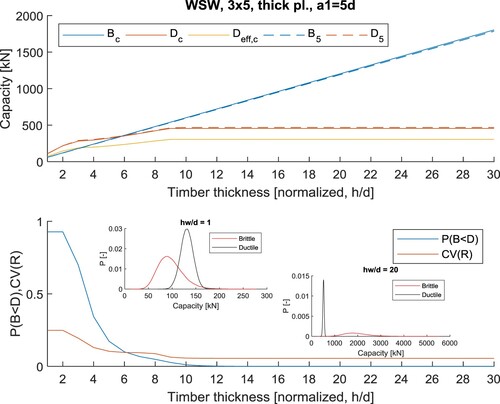
Figure 6. Effect of changing parallel spacing (a1) on characteristic strength and likelihood of brittle failure (WSW, hw=20d). (Legend: Bc – brittle resistance, Dc – characteristic ductile resistance, Deff,c – reduced characteristic ductile resistance), B5, D5 – 5th-percitle values of the simulated brittle and ductile failure capacities, P(B < D) – probability that the brittle capacity is lower than the ductile one, CV(R) – coefficient of variation of connection resistance.
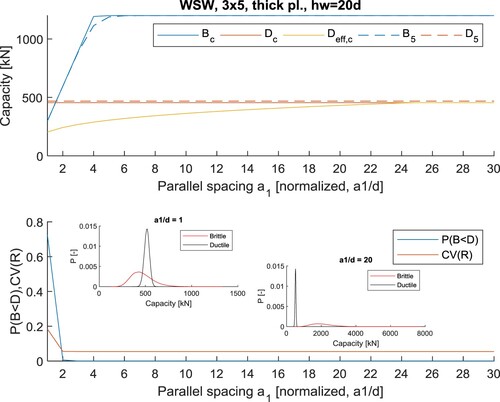
In the bottom part of and the probability that the brittle capacity is less than the ductile capacity (P(B < D)), i.e. the connection’s susceptibility to brittle failure, and the coefficient of variation of the connection’s resistance (CV(R)), R being the minimum of B and D, are given. Both decrease initially when increasing the studied parameters, i.e. hw and a1. The reduction is significant until hw = 10d (for a parallel spacing a1 = 5d) and a1 = 2d (for a relatively thick timber member, hw = 20d) respectively. It should be noted that according to practical experience for these small spacing other potential failure modes can be expected not covered in the NZ approach according to Equations (3) and (4).
shows the effect of a variation of both studied parameters in form of surface plots. In the top left the characteristic (Dc) (grid in the figure) and the 5th-percentile (D5) (shaded surface in the figure) ductile capacities are presented, whereas in the top right the characteristic (Bc) (grid in the figure) and the 5th-percetile (B5) (shaded surface in the figure) ductile capacities are plotted. Again, it can be seen, that the differences are negligible and that increasing a1 has no effect on the ductile behaviour and only up to 5d on the brittle behaviour. Increasing hw has a larger effect on both failure modes.
Figure 7. Characteristic vs 5th percentile values for ductile (top left) and brittle (top right) failure capacity; characteristic brittle vs ductile failure capacities (bottom left) and probability of brittle failure governing (bottom right) (WSW).
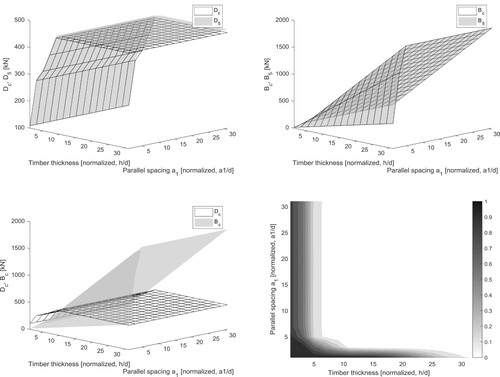
In the bottom left corner of , Dc (grid) and Bc (shaded surface) are plotted together to highlight the effect of the hw and a1 on the overall failure capacity. For low hw and a1 values brittle failure will govern the design thus the designer would avoid these configurations to obtain ductile behaviour by increasing hw or both, hw and a1. Looking at the bottom right plot in , however, it is clear, that there is region up to hw = 10d and a1 = 2d where the probability of brittle failure, i.e. that the brittle capacity is lower than the ductile one (P(B < D)), is relatively large and extra care should be taken. When using thin timber members, there is an influence of spacing on the probability of brittle failure. On the other hand, using the reduction by nef as described in the current version of EN 1995-1-1 might be too conservative as shown in and .
Connection type 2 – SWS
With regard to the SWS connection type, the same results as above are presented in this subsection. show the probability distributions for brittle and ductile failure changing hw and a1 respectively, when the other parameter is fixed. According to the brittle and ductile failure distributions overlap significantly even at higher hw/d ratios, making these connections more susceptible to brittle failure.
Figure 8. Changing of probability distributions of brittle (red) and ductile (black) failure capacities for SWS connection. Top: the effect of increasing timber thickness (hw/d) (a1=5d). Bottom: the effect of increasing parallel spacing (a1) (hw=20d).
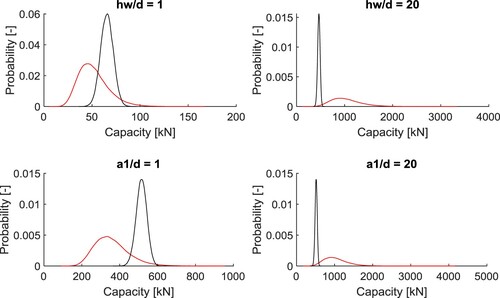
and illustrate the influence of changing hw and a1 on Bc, Dc, Deff,c, B5, D5, P(B < D) and CV(R). The difference between the characteristic and the 5th-percentile capacities is again practically negligible. The susceptibility to brittle failure and the variation in the overall connection resistance decreases with increasing hw up to about hw = 19d (, bottom) and a1 up to a1 = 2d (, bottom). According to , there is region (up to hw = 9d) where the application of nef seems unconservative. On the other hand, it might be too conservative even up to a1 = 20d, see .
Figure 9. Effect of changing timber thickness (hw/d) on characteristic strength and likelihood of brittle failure (SWS, a1=5d). (Legend: Bc – brittle resistance, Dc – characteristic ductile resistance, Deff,c – reduced characteristic ductile resistance), B5, D5 – 5th-percitle values of the simulated brittle and ductile failure capacities, P(B < D) – probability that the brittle capacity is lower than the ductile one, CV(R) – coefficient of variation of connection resistance.
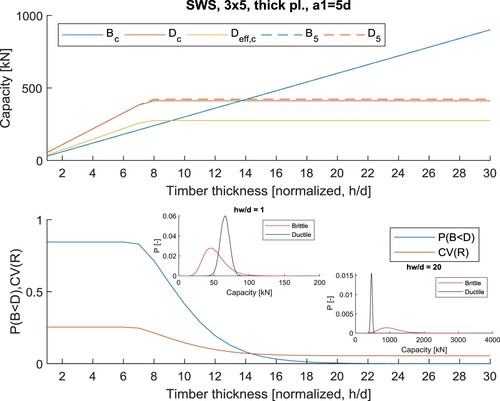
Figure 10. Effect of changing parallel spacing (a1) on characteristic strength and likelihood of brittle failure (SWS, hw=20d). (Legend: Bc – brittle resistance, Dc – characteristic ductile resistance, Deff,c – reduced characteristic ductile resistance), B5, D5 – 5th-percitle values of the simulated brittle and ductile failure capacities, P(B < D) – probability that the brittle capacity is lower than the ductile one, CV(R) – coefficient of variation of connection resistance.
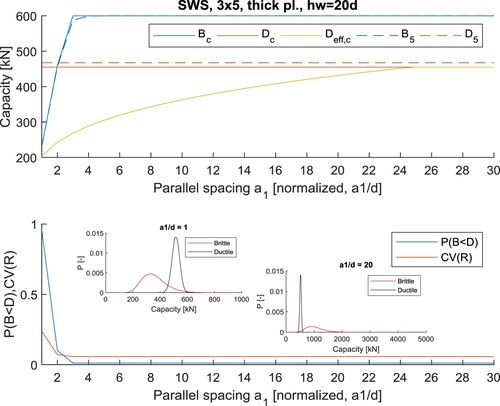
depicts the effects of both parameters on the brittle and ductile capacities and susceptibility to brittle failure of the SWS connection, in the same manner as in for WSW. The design equations would predict a susceptibility to brittle failure up to hw = 15d (bottom left), whereas the stochastic simulations indicate a susceptibility up to hw = 20d or even higher (bottom right). Like the WSW type, the SWS connection seems less likely to have brittle failure above a1 = 2d for thick timber members. The spacing has a higher influence on the probability of brittle as the timber thickness decreases. This might, however not properly be reflected in the calculations using nef in EN1995-1-1.
Conclusions
In the present study the load-carrying capacity of two different types of connections with steel dowels was evaluated by using the EYM from EC5 (EN1995-1-1, 2004) and models for brittle failure mechanisms from the NZ standard draft (Quenneville and Zaranani Citation2017) with Monte Carlo generated material properties following the recommendations in JCSS (Citation2006). From the results the following observations can be drawn:
For small timber member thickness brittle failure modes show lower load-carrying capacities compared to ductile failure modes and, hence, brittle failure governs the resistance of the connections.
With increasing the relative thickness of the timber members, hw/d, the load-carrying capacity of the ductile failure modes according to EYM reaches a plateau, whereas for brittle failure modes the capacity increases linearly. As a result, the ductile failure modes are governing the resistance of the connection for larger timber member thickness.
For small spacing between the fasteners, brittle failure modes govern the resistance of the connections.
The variability of the load-carrying capacities of the brittle failure modes is significantly larger than the variability of the ductile failure modes.
The likelihood of brittle failure modes governing the resistance is much larger for small spacing and timber member thickness.
Even when the characteristic load-carrying capacity of the ductile failure mode is smaller than the brittle failure mode, susceptibility to brittle failure can be considerable due to the large variability of the load-carrying capacities of the brittle failure modes.
For a reliable design with the desired ductile performance of the connection a sufficiently safe spacing and timber member thickness should be chosen that limits the risk of brittle failure modes to a very low percentage of the number of expected failures.
Although the current results show interesting trends, further studies are required before useful results for implementation in standards can be obtained. Recommendations for further research include:
Benchmarking of the presented models against test results is necessary.
Model uncertainties must be included into further studies if recommendations to minimize the risk of brittle failure to be developed.
Load effects and their variability should be considered in order to study the reliability of connections in realistic design situations.
The problem of overstrength of the steel of the fasteners should be studied more in detail, i.e. the problem that the actual strength of the steel fasteners might be considerable higher than accounted for in the design.
Brittle overstrength factors could be defined in order to minimize the risk of brittle failure and achieve the desired ductile failure modes with a high certainty.
Disclosure statement
No potential conflict of interest was reported by the authors.
References
- Aicher, S., Dill-Langer, G. and Klöck, W. (2002) Evaluation of different size effect models for tension perpendicular to grain strength of glulam. In: Proc of the CIB-W18 meeting 35, Kyoto, Japan, Paper No. CIB-W18/35-6-1.
- Biger, J. P., Bocquet, J. F. and Racher, P. (2000) Testing and designing the joints for the pavilion of Utopia, in: World Conference on Timber Engineering (WCTE), Whistler, Canada, Paper 4.3.3.
- Blaß, H.-J. and Colling, F. (2015) Load-carrying capacity of dowelled connections, in: Proceedings of the 48th INTER Meeting, p. INTER/48-7-3, Šibenik, Croatia.
- Bürge, M. and Schneider, J. (1994) Variability in professional design. Structural Engineering International, 4, 247–250. doi: 10.2749/101686694780601764
- Cabrero, J. M. and Yurrita, M. (2018a) A review of the existing models for brittle failure in connections loaded parallel to the grain. In C. Sandhaas, J. Munch-Andersen, and P. Dietsch (eds.), Design of Connections in Timber Structures: A State-of-the-art Report by COST Action FP1402 / WG3 (Aachen: Shaker Verlag), pp. 127–141.
- Cabrero, J. M. and Yurrita, M. (2018b) Performance assessment of existing models to predict brittle failure modes of steel-to-timber connections loaded parallel-to-grain with dowel-type fasteners. Engineering Structures, 171, 895–910. doi: 10.1016/j.engstruct.2018.03.037
- COST Action E 24 (2005) Reliability of timber structures. Several meetings and Publications. Internet Publication, available at: http://www.km.fgg.uni-lj.si/coste24/coste24.htm.
- EN 338 (2016) Structural timber – strength classes. Bruxelles (Belgium): European Committee for Standardization CEN.
- EN 384 (2016) Structural timber – Determination of characteristic values of mechanical properties and density. Bruxelles (Belgium): European Committee for Standardization CEN.
- EN 408 (2012) Timber structures – Structural timber and glued laminated timber - determination of some physical and mechanical properties. Bruxelles (Belgium): European Committee for Standardization CEN.
- EN 14080 (2013) Timber structures – Glued laminated timber and glued solid timber - Requirements. Bruxelles (Belgium): European Committee for Standardization CEN.
- EN 14358 (2016) Timber structures – Calculation and verification of characteristic values. Bruxelles (Belgium): European Committee for Standardization CEN.
- EN 1995 (2004) EN 1995-1-1:2004 - Eurocode 5: Design of timber structures - Part 1-1: General - Common rules and rules for buildings, Eurocode 5, 1(2004).
- Fink, G. (2014) Influence of varying material properties on the load-bearing capacity of glued laminated timber [Ph.D. Thesis]. Zurich (Switzerland): Institute of Structural Engineering, ETH Zurich.
- Fink, G., Honfi, D., Köhler, J. and Dietsch, P. (eds.) (2018) Basis of design principles for timber structures. A state-of-the-art report by COST Action FP1402/WG1.
- Fröderberg, M. (2015) Conceptual design strategy: Appraisal of practitioner approaches. Structural Engineering International, 25(2), 151–158. doi: 10.2749/101686614X14043795570615
- Fröderberg, M. and Thelandersson, S. (2015) Uncertainty caused variability in preliminary structural design of buildings. Structural Safety, 52(B), 183–193. doi: 10.1016/j.strusafe.2014.02.001
- Frühwald, E. (2011) Analysis of structural failures in timber structures: Typical causes for failure and failure modes. Engineering Structures, 33(11), 2978–2982. doi: 10.1016/j.engstruct.2011.02.045
- Frühwald, E., Serrano, E., Toratti, T., Emilsson, A. and Thelandersson, S. (2007) Design of safe timber structures – Report TVBK-3053, Tech. Rep., Lund University.
- Hammersley, J. M. and Handscomb, D. C. (1975) Monte Carlo Methods (London: Methuen).
- Hanhijärvi, A. and Kevarinmäki, A. (2008) Timber Failure Mechanisms in High-Capacity Dowelled Connections of Timber to Steel (Espoo: VTT Publications 677, VTT).
- Hansson, M. and Larsen, H. J. (2005) Recent failures in glulam structures and their causes. Engineering Failure Analysis, 12, 808–818. doi: 10.1016/j.engfailanal.2004.12.020
- Jensen, J. L. and Quenneville, P. (2011) Experimental investigations on row shear and split- ting in bolted connections. Construction and Building Materials, 25(5), 2420–2425. doi: 10.1016/j.conbuildmat.2010.11.050
- Jockwer, R. (2014) Structural behaviour of glued laminated timber beams with unreinforced and reinforced notches [Ph.D. Thesis]. Zurich (Switzerland): Institute of Structural Engineering, ETH Zurich.
- Jockwer, R., Fink, G. and Köhler, J. (2018) Assessment of the failure behaviour and reliability of timber connections with multiple dowel-type fasteners. Engineering Structures, 172, 76–84. doi: 10.1016/j.engstruct.2018.05.081
- Johansen, K. W. (1949) Theory of timber connections. International Association of Bridge and Structural Engineering, 9, 249–262.
- Joint Committee on Structural Safety (2006) Probabilistic Model Code, JCSS.
- Jorissen, A. J. M. (1998) Double shear timber connections with dowel type fasteners. PhD Thesis, TU Delft, The Netherlands.
- Jorissen, A. and Blaß, H. J. (1998) The fastener yield strength in bending. Proc. of the CIB-W18 meeting 31, Savonlinna, Finland. Paper No. CIB-W18/31-7-6.
- Jorissen, A. and Leijten, A. (2005) The derivation of design clauses for nailed and bolted joints in Eurocode 5. Proc. of CIB-W18 meeting 38, Karlsruhe, Germany. Paper No. CIB-W18/38-7-5.
- Klasson, A., Björnsson, I., Crocetti, R. and Hansson, E. F. (2018) Slender roof structures - failure reviews and a qualitative survey of experienced structural engineers. Structures, 15, 174–183. doi: 10.1016/j.istruc.2018.06.009
- Köhler, J. (2007) Reliability of timber structures. Dissertation, Institute of Structural Engineering, ETH Swiss Federal Institute of Technology, Zurich, Switzerland.
- Leijten, A., Köhler, J. and Jorissen, A. (2004) Review of probability data for timber connections with dowel-type fasteners. Proc. of the CIB-W18 meeting 37, Edinburgh, UK. Paper No. CIB-W18/37-7-13.
- Mistler, H. L. (2016) Design of glulam beams according to EN 1995 with regard to perpendicular-to-grain tensile strength: comparison with research results. European Journal of Wood and Wood Products, 74(2), 169–175. doi: 10.1007/s00107-015-0979-9
- Quenneville, P. (1998) Predicting the failure modes and strength of brittle bolted connections, in: Proceedings of the 5th World Conference on Timber Engineering (WCTE), vol. 2, Montreux, Switzerland, pp. 137–144.
- Quenneville, P. and Mohammad, M. (2000) On the failure modes and strength of steel- wood-steel bolted timber connections loaded parallel to grain. Canadian Journal of Civil Engineering, 27(4), 761–773. doi: 10.1139/l00-020
- Quenneville, P. and Zarnani, P. (2017) Proposal for the connection chapter of the New Zealand design of timber structures. Unpublished.
- Rossi, S., Crocetti, R., Honfi, D. and Frühwald Hansson, E. (2016) Load-bearing capacity of ductile multiple shear steel-to-timber connections. Load-bearing capacity of ductile multiple shear steel-to-timber connections. World Conference on Timber Engineering (WCTE 2016), Vienna, Austria, 22-25 August, 2016.
- Rammer, D. R. and Soltis, L. A. (1994) Experimental shear strength of glued-laminated beams. Research Paper FPL-RP-527, US Department of Agriculture, Forest Service, Forest Products Laboratory, Madison, WI.
- Sandhaas, C. and Görlacher, R. (2018) Nailed joints: Investigation on parameters for Johansen model. Timber Engineering–From Research to Standards, 64, 95–109.
- Stepinac, M., Cabrero, J. M., Ranasinghe, K. and Kleiber, M. (2018) Proposal for reorganization of the connections chapter of Eurocode 5. Engineering Structures, 170, 135–145. doi: 10.1016/j.engstruct.2018.05.058
- Stewart, M. G. and Melchers, R. E. (1988) Simulation of human error in a design loading task. Structural Safety, 5, 285–297. doi: 10.1016/0167-4730(88)90029-X
- Whale, L. and Smith, I. (1986) The derivation of design clauses for nailed and bolted joints in Eurocode 5. Proc. of CIB-W18 meeting 19, Florence, Italy. Paper No. CIB-W18/19-7-6.
- Zarnani, P. and Quenneville, P. (2014a) Group tear-out in small-dowel-type timber connections: Brittle and mixed failure modes of multinail joints. Journal of Structural Engineering, 141(2), 04014110-1–04014110-10.
- Zarnani, P. and Quenneville, P. (2014b) Strength of timber connections under potential failure modes: An improved design procedure. Construction and Building Materials, 60, 81–90. doi: 10.1016/j.conbuildmat.2014.02.049

